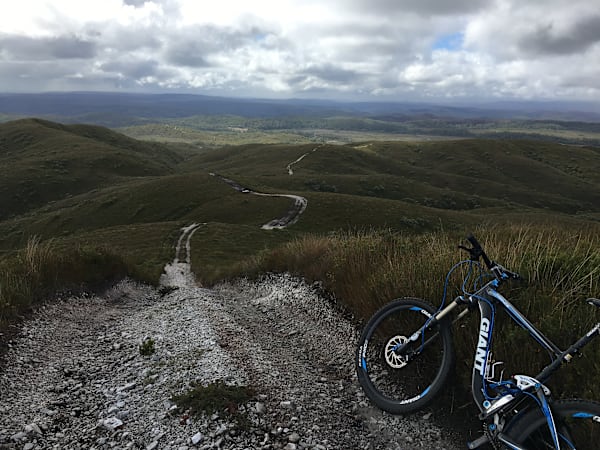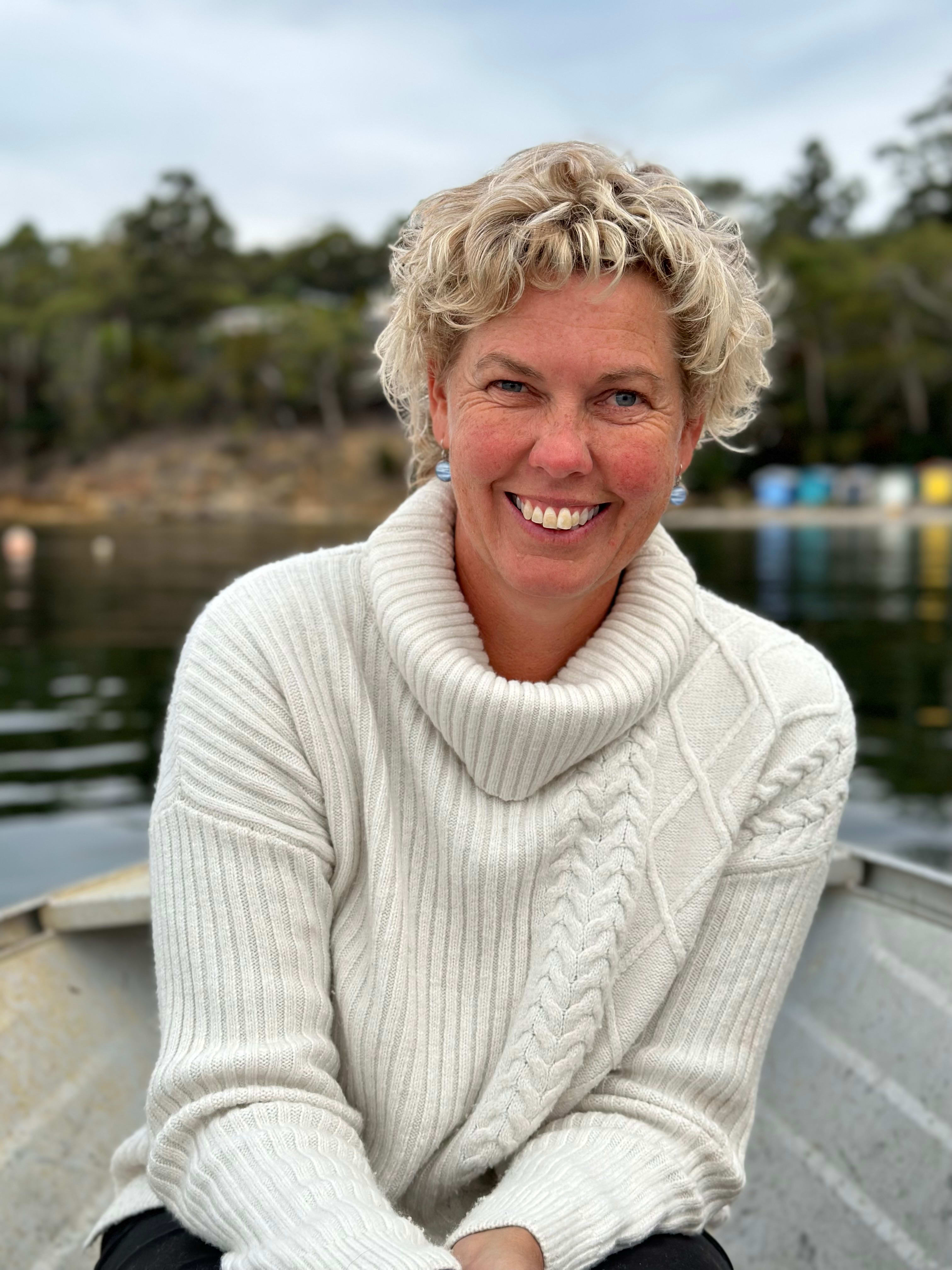Since this article's first appearance in issue 85 of Forty South magazine, the Maydena Bike Park has opened its world-class trails to families and elite riders alike. Learn more about the park and forthcoming events at maydenabikepark.com.
Mountain biking is one of the major sports in Australia in terms of numbers, with participants also spanning a large range of age and ability. The best mountain bikes tracks adapt to this varying rider ability. A 10-year-old might be able to enjoy it and ride the entire length, but when a professional rider tackles it, the track takes on a another dimension due to the rider’s speed and technical ability. Jumps appear, alternative routes appear, new obstacles and challenges appear.
For as long as mountain biking has existed, Tasmania has had great tracks, but now it has tracks designed and built by and for mountain bikers. Tasmania is becoming the national mecca for mountain biking, as it always had the potential to be. In fact, it is now becoming known internationally as the place to travel with your treadly. There are also more Tasmanians than ever enthusiastically getting on their bike.
Simon French, founder of Dirt Art, has been a key player in Tasmania becoming centre stage for mountain biking in Australia. Simon began mountain biking around the hills of Howrah, on the eastern shore of Hobart, as a child. He began exploring further afield and discovered the many and diverse trails of greater Hobart’s bushland. At the age of 12, Simon began racing national-level events and eventually represented Australia in downhill racing in 2001.

French’s passion for mountain biking led him to volunteer in a number of local trail building projects. Fast forward a few years and his trail building company, Dirt Art, has offices in Hobart, Sydney, Nelson (New Zealand) and, potentially, soon China. It employs 30 people and builds acclaimed mountain biking trails.
A great track, says Simon, showcases, and is sympathetic to, the landscape it is in. “A great track will stand the test of time, and has been designed and built to withstand local soils, climate and environment. A great track is an experience, not just a means of getting from A to B.”
A complex and thorough design process precedes the planning and building of any trail. “We undertake a comprehensive design process that includes both desktop and in-the-field site analysis. We use advanced mapping software and data to plot desired gradients and trail locations, and then use this to guide field explorations to determine final trail designs.”
Tasmania, with a diverse range of landscapes and stunning wilderness areas, is ideal. The Dirt Art team scour the landscape they are engaged in to find iconic terrain, unique views and appealing wilderness areas. “The natural environment will always dictate the style of trail for a particular site; we never force a style of trail on an area that just isn’t suitable. With such a diverse range of landscapes across Tasmania, the state already has a fantastic range of different trails.”
Tasmania has the ideal characteristics to become a mountain biking heartland.
Derby, in Tasmania’s north-east, had for years seemed like a town in decline, even when the forest industry was supposedly booming. Today, thanks to a series of world-class mountain bike trails, Derby is thriving. The doubters said, “Forestry workers can’t just serve lattes,” but the mountain biking revolution in places such as Derby brings with it a range of economic and employment opportunities, including engineering and building, track maintenance, shuttle-bussing and transport, accommodation and, of course, cafes. Even the most optimistic didn’t foresee the level of success. Today, few doubters remain.
The trails celebrate the Derby’s history and its stories, purposely passing relics hiding in the undergrowth and old mining infrastructure. The trails are named in honour of historical elements.
According to Simon French, Tasmania is small enough to become renowned as a mountain bike driving holiday destination. “In about four hours you can easily move from one end of the state to the other, and see an incredible change in landscapes. Many of Tasmania’s trails are in stunning locations, which make them highly-appealing to visiting riders. As the state continues to develop more high-quality trails, the mountain bike tourism industry will continue to grow.”

. . .
Dirt Art spent more than three months designing the Blue Tier Trail, which starts at Poimena, passes through Weldborough (for the popular pub lunch spot) before finishing at Derby. The trail was then built by Cairns-based company World Trail.
Boasting Derby, Blue Tier, Hollybank and various spots on the east coast, the north-east is currently Tasmania’s mountain bike hot spot, but not far behind it are the north-west (attracting riders to Montezuma Falls, Dial Range and Mersey River), the west coast (especially around Queenstown and Zeehan, and between Trial and Granville Harbours), and, increasingly, visitors are awakening to the magic of the Tarkine. Then there is the state’s south, boasting a mountain 1270 metres high sitting above a capital city with iconic trails such as the North-South Track, the Glenorchy Mountain Bike Park and the Meehan Range just across the Derwent River.
Originally formed to enable Simon French to undertake a few small local trail projects after many years of volunteers trail building, Dirt Art is now nearly 10 years old. It has built trails throughout Tasmania, across Australia and around the world. Demand for their services in China is expected to grow rapidly in the next few years. At the time of writing Dirt Art had teams working on trails in South Arm (Tasmania), Ballarat (Victoria), Thredbo (NSW), Jindabyne (NSW) and Nerang (Queensland).
But undoubtedly the most exciting project yet for Dirt Art, and for mountain biking in Tasmania, is the Eagles Eyrie proposal near Maydena, in the Derwent Valley. Provisional government approval has been granted for a plan that would set a new benchmark for Australian mountain bike parks. The proposal is based around Eagles Eyrie, a currently vacant multi-million dollar visitor centre and restaurant perched 600 metres above the village of Maydena. The facility is the legacy of a failed development by a past state government via Forestry Tasmania.
Maydena sits on the Lyell Highway, which connects Hobart to the west coast, including Queenstown, which is also likely to receive funding for mountain bike trail development.
The Maydena proposal will dwarf all other Australian mountain bike parks with the concept including:
• 100km of purpose-built mountain bike trails
• A focus on gravity trails (mountain and downhill), offering up to 600m vertical descending
• A showpiece trail of 20km descending an all-mountain trail through alpine rock scree and dense rainforest
• A stunning location adjacent to the Styx Valley, home to some of the world’s tallest trees
• Commercial shuttle service to summit and gravity trails
• Free access to cross country trail network
• Restaurant, café, bar and bike shop
• Tours, skills coaching, bike and equipment hire
• Potential future stages including zip lines, eco tours and bush walking
“This preliminary approval will allow us to begin developing a detailed proposal,” French explained. “There’s a lot of work to go yet, but this will be huge for mountain biking in Australia. The site is a blank canvas where we can showcase our absolute best trail concepts without the typical limitations of publically funded developments. And 600m vertical, accessed via a shuttle road, with a multi-million dollar visitor centre at the summit – how good is that!”
. . .
To French, the measure of trail building success is simple. “I know we have succeeded when trails are sustainable and when we see lots of local and visiting riders out enjoying them.”
After such a long experience of so many tracks in so many places, can Simon French choose a favourite? He can, it’s the Juggernaut Trail at Hollybank, just outside of Launceston. “The trail is a 10km descent through a range of forest types, and is renowned for its unique style of technical and flow trail terrain. The trail was the first of its kind in Australia, and has paved the path for many other long, descending trails since.”
Simon clearly has the ideal qualities for a track designer and builder. “I love the freedom of mountain biking, I love exploring the wilderness, and the rush of descending down great trails,” he says.
Fast-forward five years and it seems safe to predict that Tasmania will be well-known internationally by the mountain biking fraternity as a must-visit destination. And local participation can only increase.
All images from the Hollybank Project, and all credited to Flow Mountain Bike.
James Dryburgh: A publisher once told James that when he is asked for his bio, he should say: “James writes subversive essays about important things.” James felt a bit awkward about saying this publicly, but secretly he liked it. He has written for many publications. His books are Essays from Near and Far, Walleah Press, 2014 and The Balfour Correspondent, Bob Brown Foundation, 2017.








